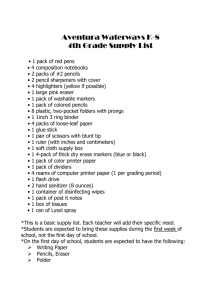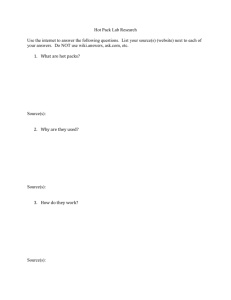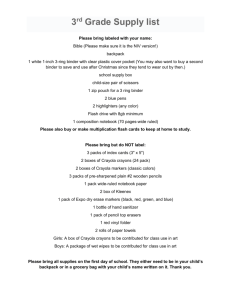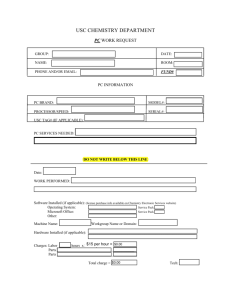Hot Pack-Cold Pack_H
advertisement
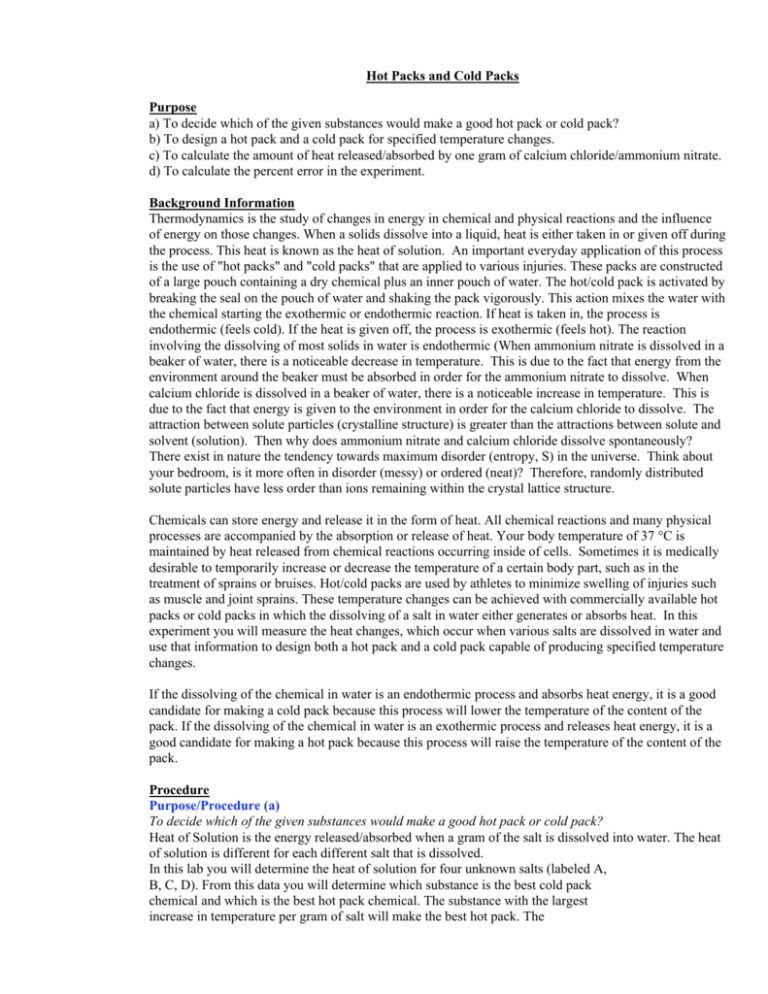
Hot Packs and Cold Packs Purpose a) To decide which of the given substances would make a good hot pack or cold pack? b) To design a hot pack and a cold pack for specified temperature changes. c) To calculate the amount of heat released/absorbed by one gram of calcium chloride/ammonium nitrate. d) To calculate the percent error in the experiment. Background Information Thermodynamics is the study of changes in energy in chemical and physical reactions and the influence of energy on those changes. When a solids dissolve into a liquid, heat is either taken in or given off during the process. This heat is known as the heat of solution. An important everyday application of this process is the use of "hot packs" and "cold packs" that are applied to various injuries. These packs are constructed of a large pouch containing a dry chemical plus an inner pouch of water. The hot/cold pack is activated by breaking the seal on the pouch of water and shaking the pack vigorously. This action mixes the water with the chemical starting the exothermic or endothermic reaction. If heat is taken in, the process is endothermic (feels cold). If the heat is given off, the process is exothermic (feels hot). The reaction involving the dissolving of most solids in water is endothermic (When ammonium nitrate is dissolved in a beaker of water, there is a noticeable decrease in temperature. This is due to the fact that energy from the environment around the beaker must be absorbed in order for the ammonium nitrate to dissolve. When calcium chloride is dissolved in a beaker of water, there is a noticeable increase in temperature. This is due to the fact that energy is given to the environment in order for the calcium chloride to dissolve. The attraction between solute particles (crystalline structure) is greater than the attractions between solute and solvent (solution). Then why does ammonium nitrate and calcium chloride dissolve spontaneously? There exist in nature the tendency towards maximum disorder (entropy, S) in the universe. Think about your bedroom, is it more often in disorder (messy) or ordered (neat)? Therefore, randomly distributed solute particles have less order than ions remaining within the crystal lattice structure. Chemicals can store energy and release it in the form of heat. All chemical reactions and many physical processes are accompanied by the absorption or release of heat. Your body temperature of 37 °C is maintained by heat released from chemical reactions occurring inside of cells. Sometimes it is medically desirable to temporarily increase or decrease the temperature of a certain body part, such as in the treatment of sprains or bruises. Hot/cold packs are used by athletes to minimize swelling of injuries such as muscle and joint sprains. These temperature changes can be achieved with commercially available hot packs or cold packs in which the dissolving of a salt in water either generates or absorbs heat. In this experiment you will measure the heat changes, which occur when various salts are dissolved in water and use that information to design both a hot pack and a cold pack capable of producing specified temperature changes. If the dissolving of the chemical in water is an endothermic process and absorbs heat energy, it is a good candidate for making a cold pack because this process will lower the temperature of the content of the pack. If the dissolving of the chemical in water is an exothermic process and releases heat energy, it is a good candidate for making a hot pack because this process will raise the temperature of the content of the pack. Procedure Purpose/Procedure (a) To decide which of the given substances would make a good hot pack or cold pack? Heat of Solution is the energy released/absorbed when a gram of the salt is dissolved into water. The heat of solution is different for each different salt that is dissolved. In this lab you will determine the heat of solution for four unknown salts (labeled A, B, C, D). From this data you will determine which substance is the best cold pack chemical and which is the best hot pack chemical. The substance with the largest increase in temperature per gram of salt will make the best hot pack. The substance with the largest decrease in temperature per gram of salt will make the best cold pack. 1) Add exactly 50.0 mL of deionized water to the calorimeter. 2) Weight exactly 3.0 g of a salt into a weighing boat. 3) Record the initial temperature of the water in the calorimeter using the temperature probe. 4) Pour the salt from the weighing boat into the calorimeter water. 5) Use the stirring rod to stir the solution. You want to dissolve the salt as quickly as possible. You may have to use a stirring rod to break up clumps. 6) Record the highest (or lowest) temperature that is reached after the salt is completely dissolved using the temperature probe. 7) Rinse out the calorimeter. 8)Repeat the procedure for the other 3 salts. You may test the salts in any order. Record Observations for each chemical trial Calculations: For each salt, determine the effectiveness of each salt in terms of change in °C per gram of salt. Salt A Salt B Salt C Salt D Appearance Change in temp. (∆T) ∆T/g Good candidate for hot pack or cold pack? Conclusion (a): Report to the purpose. Purpose/Procedure (b,c,d) b) To design a hot pack and a cold pack for specified temperature changes. c) To calculate the amount of heat released/absorbed by one gram of calcium chloride/ammonium nitrate. d) To calculate the percent error in the experiment. You are working for a company "Household Injuries" who wishes to develop a hot and cold pack. Each pack will contain 200 mL of water. Your job is to determine how much NH4NO3 must be in the "cold pack" to lower the temperature to 5 °C and how much CaCl2 must be in the "hot pack" to increase the temperature to 80 °C. Procedure 1) Measure out exactly 200 mL of water and add it to the calorimeter. 2) Measure the initial temperature of the water using the temperature probe. 3) Weigh out 5 g of the solid. 4) Add the solid to the water with constant and consistent stirring. You want to dissolve the salt as quickly as possible. You may have to use a stirring rod to break up clumps. 5) Determine the maximum or minimum temperature for this process. 6) Repeat this process using different amounts of each solid (10g, 15g, 20g, 25g). Data: Mass of CaCl2(g) Initial T of water (°C) Final T of solution (°C) ∆T (°C) Mass of NH4NO3(g) Initial T of water (°C) Final T of solution (°C) ∆T (°C) Calculations: 1. Calculate the temperature change (∆T) of the 25g of CaCl2 and water reaction. 2. Calculate the heat gained by the solution using the equation below: Assume the specific heat of the solution is equal to the specific heat of water. The specific heat of water is 4.184 J/g. (Q = m x s x ∆T) Where: Q= heat lost or gained m = mass of solution in the calorimeter s = specific heat of substance Tf – Ti = change in temperature (also referred to as ∆T) QH2O = mH2O x sH2O x ∆TH2O Q CaCl2 = 3. Calculate the amount of energy (in Joules) released per gram of CaCl2. Remember: Q is the opposite sign of the value you calculate. 4. Calculate the amount of energy (in Joules) released per mol of CaCl2. 5. Calculate the temperature change (∆T) of the 25g of NH4NO3 reaction. 6. Calculate the heat gained by the solution using the equation below: Assume the specific heat of the solution is equal to the specific heat of water. The specific heat of water is 4.184 J/g. (Q = m x s x ∆T) Where: Q= heat lost or gained m = mass of solution in the calorimeter s = specific heat of substance Tf – Ti = change in temperature (also referred to as ∆T) QH2O = mH2O x sH2O x ∆TH2O Q NH4NO3 = 7. Calculate the amount of energy (in Joules) absorbed per gram of NH4NO3. Remember: Q is the opposite sign of the value you calculate. 8. Calculate the amount of energy (in Joules) absorbed per mol of NH4NO3. 9. Look at the reactions below. Place the energy value on the appropriate side of the two equations. (Hint: use answers from questions 4 and 8) CaCl2(s) Ca+2 (aq) + 2Cl- (aq) NH4NO3(s) NH4+(aq) + NO3- (aq) 10. When CaCl2 dissolves in water the true value for Q = –747 J/g. When NH4NO3 dissolves in water the true value for Q = 326 J/g. Compare your experimental values by calculating the percent error for each reaction. % Error = Experimental Value – Actual Value x 100 Actual Value Graphing: Plot the maximum temperature of the system (on Y axis) Vs the mass of CaCl2 (on X axis) used. Plot the minimum temperature (on Y axis) Vs the mass of NH4NO3 (on X axis) used. Extrapolate each graph to the required temperature. Conclusion (b,c,d): From the graphs determine the amount of solid that should be used in each pack. Include graphs and explain your analysis and conclusion using the graphical values. Report the amount of heat released/absorbed by one gram of calcium chloride/ammonium nitrate. Report the % error in the lab. Overall Conclusion: Report to the purposes (all purposes) of the lab before you discuss the questions. Questions: 1. a. Which salt (A,B,C,D) from procedure (a) would make the most effective hot pack? Why? b. Which salt (A,B,C,D) from procedure (a) would make the most effective cold pack? Why? 2. a. How many grams of CaCl2 was required to produce a temperature of 80 °C? b. How many grams of NH4NO3 was required to produce a temperature of 5 °C? 3. a) For the most effective hot pack, was the change in temperature positive or negative? b) Therefore, which one, reactants or products have more energy? How do you know? Draw the energy/enthalpy diagram for this change. c) Was this change exothermic or endothermic? 4. a) For the most effective cold pack, was the change in temperature positive or negative? b) Therefore, which one, reactants or products have more energy? How do you know? Draw the energy/enthalpy diagram for this change. c) Was this change was exothermic or endothermic? 5. How do you know that a reaction is "exothermic” based on the temperature change? 6. How do you know that a reaction is "endothermic” based on the temperature change? 7. How do cold packs and hot packs work? (Research) 8. Who uses hot packs and cold packs? (Research) 9. What is the chemical that is used in hot packs that use a super cooled fluid? Why is that chemical a good choice for use to manufacture a hot pack? (Research) 10. Was there a physical or a chemical change in the experiment that you did? 11. How does varying the starting temperature affect the size of the temperature change (∆T)? 12. Discuss at least three valid errors that might have occurred as a result of this procedure. Suggest improvements. 13. Why do you think the solutions became cold/hot when dissolved in water? 14. What do you think is happening at the molecular level (refer example in the picture below)? Draw a basic diagram for NH4NO3 at the molecular level that illustrates the dissolving process. In each case, identify the system and surrounding. 15. How would you apply the law of conservation of energy to the situation with the cold pack? 16. What is the difference between the heat of reaction, qrxn, and the enthalpy of reaction, ∆Hrxn? 17. Predict what you think you'd find if you could measure the total energy in the bag before and after the bag was activated. 18. Calcium chloride is used to melt ice on winter roads. Would that process be exothermic or endothermic? Why? 19. Describe why your skin feels cool when a cold pack is applied and warm when a hot pack is applied. 20. What chemistry theme explains the concepts of this lab? 21. Indicate one other real life application where thermochemistry is involved.
